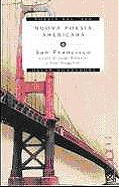Nuova Poesia Americana – San Francisco is the second volume (
There are some gems of inclusion here – Kaufman is one example, too often by-passed for any other member of the Beats, or James Schevill, the Berkeley-born poet who, having refused to sign the loyalty oath at the University of California, went on to become perhaps the defining director of the San Francisco Poetry Center before moving to Providence in the mid-60s, or Ronald Johnson, long a San Francisco poet before he returned to his native Kansas in the last decade of his life, whose prickly personality kept him from being fully active in any of San Francisco’s various literary communities. And I was ecstatic to see George Stanley included, given his importance to the scene in the 1960s. Like Joanne Kyger, also present & accounted for,
There are choices here as well – this is a 500 page book, but because everyone is represented by work in both English and Italian, it has the range one might expect from a collection half its size. Contrast this with Stephanie Young’s Bay Area Poetics, which has roughly the same number of pages, but 109 contributors. It’s great to see work by Norma Cole, Leslie Scalapino & Laura Moriarty in Nuova Poesia Americana, but Jean Day, Kit Robinson & Bev Dahlen are absent. The
Given the space constraints, I wonder actually about my own inclusion here, as well as that of Jeff Clark, since both of us have moved on to other parts of the country. I did live in the Bay Area – in San Francisco as well as three different cities in the East Bay (Albany, Berkeley, Oakland, to be precise) – for over 45 years and I’d be lying to say that I wasn’t pleased to be thought of in this context, just as I am to have a plaque on Berkeley’s poets’ walk on Addison. But when resources are finite, it feels odd to be on board when others are not. And it raises the question of all the other poets who made their mark first in the Bay Area before moving elsewhere: Rae Armantrout, Erica Hunt, Stan Persky, Bob Perelman, Barrett Watten, Jack Gilbert, Carla Harryman, Kathy Acker, Tom Mandel, Shirley Kaufman, John Wieners, James Liddy, Ted Pearson, Linda Gregg, Andrei Codrescu, Bobbie Louise Hawkins, Myung Mi Kim, Larry Fagin, Mary-Margaret Sloan, Arthur Sze, Lytle Shaw. Even Louis
Simpson.
Two larger absences are writing from people of color – Ishmael Reed & Kaufman are the only representatives among the 29 contributors – and writing explicitly related to the feminist movement, such as the work of poets like Pat Parker & Paula Gunn Allen, Judy Grahn or Susan Griffin. Parker & Allen would have helped on both counts. The feminist literary movement that first emerged in the 1970s is inconceivable without the presence of the Bay Area, and those writers were hardly cordoned off from the rest of the scene. Susan Griffin & I both took the same classes at San Francisco State, Parker & I read together quite regularly in the open reading series at Shakespeare & Co Books in Berkeley in the mid-1960s, Grahn & Allen both read at the Grand Piano. (Some others, like Kathleen Fraser, Frances Jaffer & Edith Jenkins, clearly drew from both that world as well as the heritage of the post avant – none of them here either.) I can make virtually the same argument for more than a few poets of color, from Al Young to Al Robles to Ntozake Shange to Janice Mirikitani to David Henderson to Jessica Hagedorn to William Anderson to Victor Hernandez Cruz to Nate Mackey to Harryette Mullen – all are completely a part of the history of Bay Area poetries. Big Oops not find at least two or three more of them here.
Some of this may just be a combination of space limitations and the difficulty of editing an anthology of this kind at some distance – Vangelisti is a long-time






